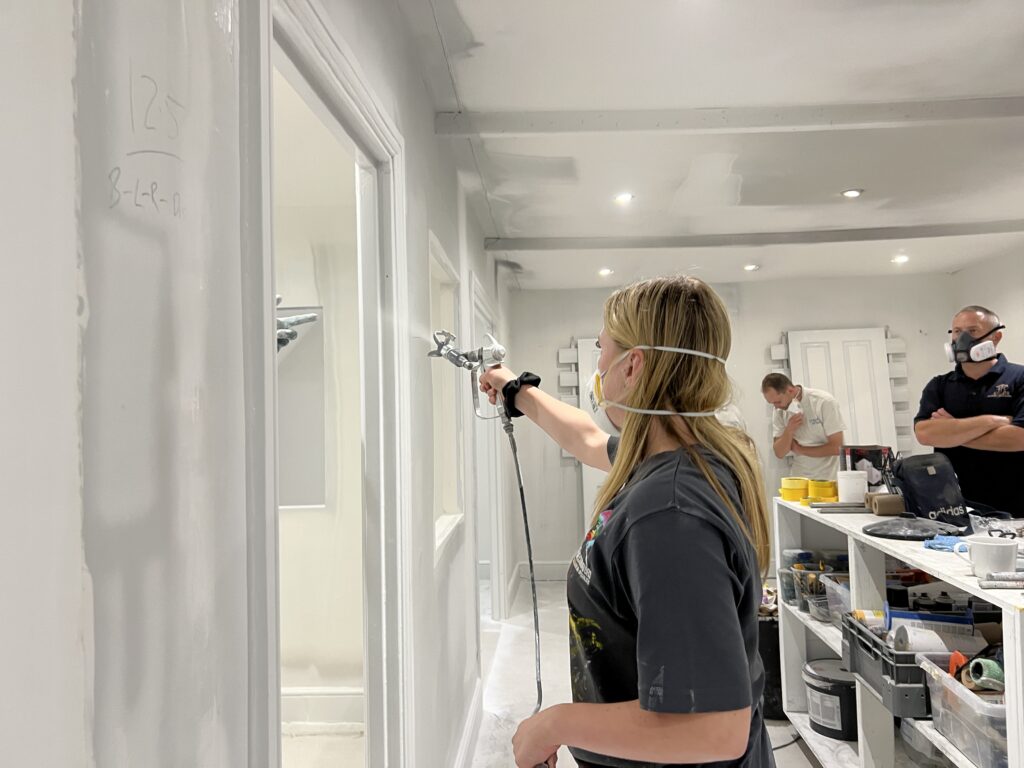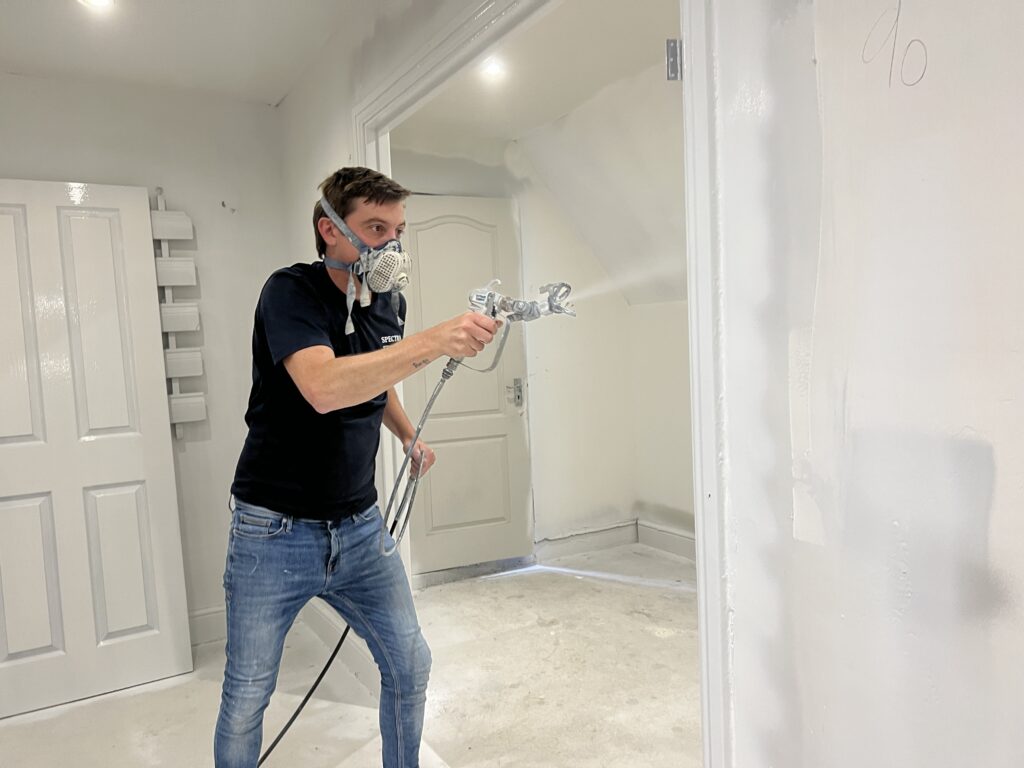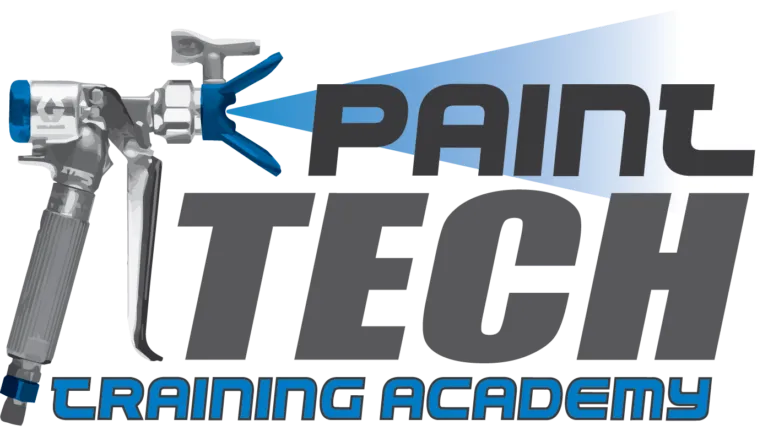In our previous blog, we discussed five of the most common mistakes when spraying. We covered overspray, being too close, arching the gun, incorrect pressure settings, and moving the gun – five crucial aspects to master for achieving the best results in spraying and avoiding the traditional mistakes often made by untrained decorators or those who think they can replicate skills after watching a single YouTube video.
Currently, you have one of the greatest opportunities at your fingertips. Spraying is a thriving skill in the UK, with more people recognising its advantages. It’s not just decorators and tradespeople; even homeowners are now seeking that distinctive look and feel. Consequently, customers are actively seeking out spraying specialists over traditional decorators.
However, this growing trend has also led to bad actors, and an increase in poorly executed jobs. Companies claiming to ‘spray in a day’ are causing significant issues with overspray on unprotected surfaces where they were too lazy to mask, as well as leaving runs and bad finishes. These problems could have easily been avoided by taking the necessary time and care.
So, if you invest the time now to learn the correct techniques and establish yourself as a local, ethical, professional tradesperson, the opportunities for jobs are abundant. You have the chance to earn the profits you’ve always envisioned.
To help get things right we’re going to pick up on 3 more mistakes that people make, so you can learn and avoid getting it wrong.

The wrong size tip is selected.
It’s crucial to select the appropriate tip size when utilising a paint sprayer to guarantee an efficient and effective painting process. The size of the tip directly influences the width of the fan pattern and, consequently, the paint coverage. Despite this, many unskilled individuals tend to use the same tip for all applications creating serious problems and bad workmanship.
Understanding Tip Sizes:
Paint sprayer tips are categorised by their three-digit number, where the first digit represents the fan width, and the last two digits indicate the size of the orifice in thousandths of an inch. For instance, a 517 tip signifies a 10-inch fan width with a 0.017-inch orifice.
Understanding the relationship between the width of the fan pattern and the size of the area being painted is crucial. It’s like choosing the right brush for a specific job. Utilising the wrong size tip can lead to either excessive overspray or insufficient coverage, which, more importantly, impacts the bottom line through wasted time and paint.
Large Wall Area vs. Small Skirting Area:
Every blog needs a comparison, so let’s explore tip sizes when spraying both large and small walls. Choosing a 517 tip, which offers a 10-inch fan width, ensures efficient coverage for a large wall. However, on a small skirting, it would lead to excessive overspray, reaching onto the walls, and all over the floor! Therefore, for a small skirting, a 310 tip with a 6-inch fan width and reduced paint output is more appropriate.
Overlapping each pass
Let’s discuss the concept of overlapping. What is the correct percentage of overlap per pass? This is one of those spraying skills that many people tend to overlook, either because they are unaware of it or don’t consider it important enough to learn. We often observe a casual “it’ll be okay, as long as the wall is covered ” approach to getting the passing right. However, understanding the overlap rule is crucial for achieving the desired results.
The amount of overlap per pass may not sound surprising when you first hear it, it’s an obvious aspect. For each pass, you should aim for a 30-50% overlap to prevent the occurrence of “banding”, stripes or uneven coverage when the surface dries.

Understanding the Overlapping Concept:
When using a paint sprayer, the technique of overlapping each pass is like layering strokes with a brush. Like brushing, where you pass back over the previous stroke by around 50%, the goal is to ensure there is even coverage and to provide the wall with the right amount of paint. This principle applies to spraying as well; it serves the purpose of ensuring consistent coverage, preventing uneven patches, and achieving a seamlessly blended finish.
Banding:
Inadequate overlapping between passes can lead to banding, characterised by visible stripes or lines in the final paint. This is also caused by choosing the wrong tip type but we may cover that in another blog. This issue arises when each pass fails to seamlessly blend with the previous one, creating noticeable gaps once the paint dries. Banding can be corrected, but only if it is detected during the painting process.
When spraying you should trigger on and trigger off after each pass
The final tip in this blog is something often overlooked by those without training, but when executed correctly, it can make a massive difference, and that’s controlling the trigger on and off when spraying. The beauty of understanding trigger control is that, when it becomes a habit, it turns into an automatic instinct in your spraying technique. But when failing to master this aspect it can lead to various issues, such as applying heavy coats due to hesitation, achieving uneven finishes, and experiencing unsightly runs in the paint.

Trigger Control Explained:
Trigger control refers to the art of activating and deactivating the sprayer’s trigger at the right moments during each pass. This technique ensures a consistent and even distribution of paint, preventing issues that may arise from continuous spraying.
The Danger of Continuous Spraying:
The second biggest issue, after using the wrong tip, that most ‘spray in one day’ sprayers face is not triggering their gun correctly. This can cause significant trouble. Continuous application of paint without triggering on and off at the right times can lead to a buildup of paint at the end of each pass. This excess accumulation often results in heavy coats, which not only wastes paint but also create an uneven surface that can be challenging to correct, particularly at the top and bottom if spraying up and down. Even though the excess paint at the bottom looks bad, it’s the excess paint at the top that should be a real concern, as it is prone to running, creating visible streaks and drips that can ruin the overall quality of the paint job.
How to Avoid Heavy Coats and Runs:
To achieve optimal results, initiate the trigger at the beginning of each pass, maintain a consistent speed, and deactivate the trigger at the end. This guarantees an even distribution of paint throughout the entire pass, preventing the accumulation of excess paint at the finish. Ensure proper masking to enable spraying beyond the end of the wall, eliminating the need to deactivate the trigger before reaching the end.
The Importance of Consistency:
“Consistency in triggering on and off is crucial. It may take some practice to get the timing just right, but the effort pays off in the form of a professional-looking, even finish. Regularly checking the surface for any signs of heavy coats or runs during the painting process allows for immediate correction.
Training is key.
Although the points listed above and in the previous blog seem obvious and something you can manage now that we’ve pointed them out, there is still no substitute for training. Taking a course with us can be the key difference to getting the basics right and learning from them, instead of acquiring bad habits and heading down the wrong route. Our academy tutors have trained thousands of people to be sprayers, giving them the best skills and knowledge to get started in what is becoming a tough and crowded sector.





